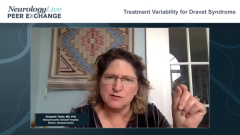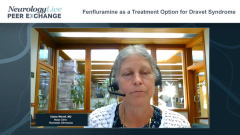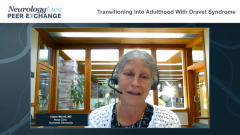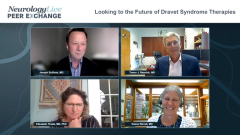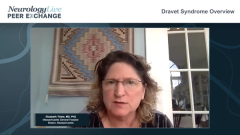
Importance of Early Diagnosis for Dravet Syndrome
Trevor J. Resnick, MD, and Elaine Wirrell, MD, explain why the early diagnosis of Dravet syndrome is important, which patient profiles should be noted for ordering genetic testing, and what to do with those results.
Episodes in this series

Joseph Sullivan, MD: We have this clinical picture of the typically developing child who comes in with their first, maybe prolonged seizure in the setting of fever and is very often diagnosed with febrile seizure. Trevor, how can we make this diagnosis early? What tools do we have? Why is it so important to make this diagnosis early? What’s the big deal? Epilepsy is epilepsy, right? Can you go into that?
Trevor J. Resnick, MD: Yes and no. I remember back to the first case of Dravet syndrome I had about 28 years ago, not making the diagnosis, and using the wrong medication. For most parents, when you have a child with a devasting illness presenting with episodes of status epilepticus and prolonged febrile seizures, the unknown is a significant stressor. Even if you have a label like Dravet syndrome, which is a severe neurological disorder, it’s something that the parents can understand. They have an idea of what they have to deal with. As difficult as it is, it’s better than not knowing. Knowing the diagnosis has created a situation where we don’t make the kinds of mistakes that I made 28 years ago. We know which medications to avoid. Probably the most significant thing with the diagnosis of Dravet syndrome is knowing what not to do. Being able to have the gene mutation, which in 80% of the cases is associated with a clinical picture, has been a significant advance for us as neurologists. Knowing what to do, knowing what not to do, and being able to give parents a framework with which they can function in the future has made a major difference. That’s why it’s so important.
Joseph Sullivan, MD: Let’s build upon that. With the availability of genetic testing now in most areas of the country, what do you think is a typical presentation where someone should order genetic testing? Is it the 6-month-old who comes in with their first 15-minute long hemiclonic seizure? Is it someone who comes in with a generalized seizure that lasts for 5 minutes but also at 6 months old in the setting of a vaccine? Maybe we can all weigh in on this because I don’t think there is any right or wrong answer. Let’s start with you, Trevor.
Trevor J. Resnick, MD: If you ask 5 epileptologists this question, you may get 5 different answers.
Joseph Sullivan, MD: I suspect I’m going to get 3 today.
Trevor J. Resnick, MD: Our threshold has lowered significantly over the years. Before, something like generalized febrile status and hemiclonic febrile status may have been an indication to do the testing. Now, with babies 6 or 8 months old presenting with more than 1 prolonged febrile seizure or a febrile hemiclonic seizure, most people get testing. In the beginning, it was also difficult because of the cost issue of getting it approved. The ability to get it in kids that age pretty easily without concern of cost has gotten us to the point where if we think of it, we get it. And we’re thinking of it earlier and in many more patients.
Joseph Sullivan, MD: Elizabeth, what are your thoughts?
Elizabeth Thiele, MD, PhD: I completely agree with Trevor. It used to be very difficult for us to get the payers to reimburse for the genetic testing, so it would be more going by the clinical phenotype and calling it Dravet syndrome once we suspected it. Then it was even difficult for us to get testing for the gene. Now that it’s more readily available without a financial burden for the family, our threshold for getting it is much lower. Definitely get it after a prolonged seizure in a child that age, hemiclonic, with no family history of febrile seizure. The other important reason for early diagnosis is because of the evolving therapies, with the thought that more effective treatment could really impact outcomes.
Joseph Sullivan, MD: Elaine, what are your thoughts? I have 1 other topic to add. What if we get the genetic testing in these patients with this typical presentation, and it comes back normal? Maybe you could add some color to how confident we can be based on which constellation of clinical findings, where you can still put your nickel down and say, “I still think you have Dravet syndrome.”
Elaine Wirrell, MD: First of all, I agree with Trevor and Elizabeth about getting the genetic testing. One thing you have to be aware of is that not every SCN1A pathogenic variant is associated with Dravet syndrome. Even if the SCN1A comes back positive, sometimes you can get information, and they’ll say, “Yes, that has been highly correlated with Dravet syndrome,” or it’s a truncation variant, which are much more commonly associated with Dravet syndrome. But sometimes you get it and you don’t really know, and you’re not sure if it’s going to evolve into Dravet syndrome, or if it’s going to be more of a GEFS+ [genetic epilepsy with febrile seizures plus]. That’s where you really need to look at the results of your genetic testing in context with your clinical picture of the infant in front of you. Certainly, if that infant has had recurrent prolonged hemiconvulsive seizures, starting at 5 or 6 months old, you’d be pretty suspicious that it’s Dravet syndrome.
The tougher thing is: What happens if that genetic testing is negative? As you know, that doesn’t exclude Dravet syndrome, but we know that well over 85% of children with Dravet syndrome will have a SCN1A pathogenic variant. You want to make sure you’ve done careful genetic analysis and that you’ve looked at the SCN1A gene very carefully. With even most of the people who are said to be SCN1A-negative, if you do careful analysis, you can find variants there. There are also some other genes that can sometimes look a little like Dravet syndrome, for example protocadherin-19. Those kids tend to present more with clusters of brief febrile seizures. There are some that can look similar to Dravet syndrome but are a little different. I’ve certainly had kids with clinical Dravet syndrome who remain gene-negative. Sometimes it’s a clinical diagnosis, but you’d be cautious about making that within the first year of life before you actually saw a clearer evolution.
Joseph Sullivan, MD: I’m glad you brought up the GEFS+. It’s been a while since I’ve made a new diagnosis of Dravet syndrome. Five years ago, I’d get referred a 5-year-old patient with just bad epilepsy. You review their history and you’re like, “Wow, you actually have Dravet syndrome.” Now, because child neurologists and even pediatricians are ordering some of these epilepsy gene panels and maybe stumbling upon an SCN1A diagnosis, the question that I now get is, “Is this Dravet or is this GEFS+?” That’s where you’re taking both the specifics of the genetic variant together with the clinical history; there’s still always going to be some of that gray area of uncertainty that even at a year of age, you maybe can’t tell. Putting all of these pieces together allows us to make that diagnosis with the genetic background. We didn’t get so many different answers. We’re all pretty much on the same page.
Thank you for watching this NeurologyLive® Peer Exchange. If you enjoyed the content, please subscribe to our e-newsletters to receive upcoming Peer Exchanges and other great content right in your inbox. Thank you.
Transcript Edited for Clarity
Newsletter
Keep your finger on the pulse of neurology—subscribe to NeurologyLive for expert interviews, new data, and breakthrough treatment updates.


